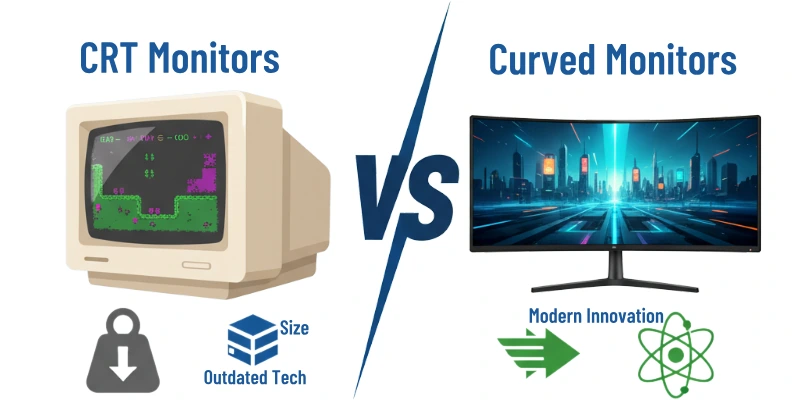CRT Monitors vs Curved Monitors: What’s the Difference?
Published: 5 May 2025
Display technology has come a long way from bulky CRT monitors to sleek, modern curved screens. CRT (Cathode Ray Tube) monitors were once the standard for computing but are now largely obsolete. Curved monitors offer a more immersive viewing experience and are common in modern gaming and productivity setups.

This article compares these two technologies to help you understand their differences and how each serves different needs.
Differences between CRT Monitors and Curved Monitors
Let’s talk about differences between Curved Monitors and CRT Monitors to better understand:
1. Display Technology
CRT Monitors: Use cathode ray tubes to generate images. Emit light through electron beams striking phosphor screens. Have deep and bulky cabinets due to tube size. Tend to flicker at lower refresh rates. Limited to analogue signal processing.
Curved Monitors: Use LCD or OLED panels with a curved screen shape. Provide a better field of view and less distortion. Digital signal processing with sharper image quality. Available in various curvature levels (e.g., 1800R, 1500R). Offer modern backlighting technologies for vivid visuals.
2. Image Quality
CRT Monitors: Display deep blacks and natural colour blending. Can support multiple resolutions without quality loss. Lower sharpness compared to modern displays. Prone to screen burn-in over time. Colours may degrade with age.
Curved Monitors: Offer high resolution, contrast, and colour accuracy. Excellent for immersive gaming and media consumption. Uniform image quality across the screen. Enhanced viewing angles in ultrawide formats. Ideal for multitasking with large screen real estate.
3. Size and Weight
CRT Monitors: Bulky and heavy due to tube-based construction. Hard to move and transport. Require deep desks or wide shelves. Screen sizes typically range from 14” to 21”. Not suitable for modern desk setups.
Curved Monitors: Slim, lightweight, and space-saving. Easy to wall mount or reposition. Sleek design fits modern workspaces. Available in large sizes, even over 49 inches. Better for ergonomic setups.
4. Eye Comfort and Viewing Experience
CRT Monitors: Flickering can cause eye strain over long use. Low refresh rate and brightness adjustment options. No blue light filters or eye care features. Viewing angle not optimal in larger sizes. Older screens may appear blurry or dim.
Curved Monitors: Reduced glare and distortion due to the curve. Offer eye-care features like blue light filters. Higher refresh rates reduce eye fatigue. Provide a natural, wrap-around view. Great for long hours of work or gaming.
5. Power Consumption
CRT Monitors: Consume more power due to electron beam operation. Generate significant heat during use. Not energy efficient compared to modern displays. Often requires a dedicated power source. Not eco-friendly in the long run.
Curved Monitors: Use energy-efficient LED or OLED panels. Lower heat emission and power usage. Support power-saving features and modes. More environmentally friendly. Suitable for 24/7 use in offices or studios.
6. Availability and Support
CRT Monitors: No longer manufactured on a large scale. Difficult to find spare parts or repair services. Mostly available in second-hand markets. Not compatible with modern HDMI or DisplayPort. Obsolete for most modern use cases.
Curved Monitors: Widely available in electronics and online stores. Supported by all modern operating systems and GPUs. Easy to find accessories and compatible mounts. Regularly updated with new features and designs. Reliable customer and manufacturer support.
7. Applications and Use Cases
CRT Monitors: Still used in retro gaming and legacy systems. Preferred by some artists for specific analogue effects. Found in vintage tech collections. May be used in labs or testing environments. Not ideal for modern professional or gaming tasks.
Curved Monitors: Popular in gaming, video editing, and design work. Ideal for immersive experiences and multitasking. Used in offices for improved productivity. Great for stock trading, content creation, and media. Replace multi-monitor setups efficiently.
8. Lifespan and Maintenance
CRT Monitors: Shorter lifespan due to tube degradation. Require regular degaussing and adjustments. Difficult and costly to maintain. Can suffer from screen flicker and image distortion. Risk of electric shock during servicing.
Curved Monitors: Long lifespan with LED/OLED technology. Minimal maintenance required. Simple cleaning and software updates. Reliable performance over years. Warranties and repair services readily available.
✅ Quick Comparison Table: CRT Monitors vs Curved Monitors
Here is a quick comparison table of Curved Monitors vs CRT Monitors:
| Feature | CRT Monitors | Curved Monitors |
| Technology | Cathode Ray Tube | LCD/OLED with curved design |
| Image Quality | Good colours, but less sharp | High resolution, vivid colours |
| Size & Weight | Bulky and heavy | Slim and lightweight |
| Eye Comfort | Can cause eye strain | Reduced glare and more comfort |
| Power Usage | High power consumption | Energy-efficient |
| Availability | Rare, discontinued | Widely available |
| Best Use Case | Retro gaming, legacy systems | Gaming, design, productivity |
| Maintenance | High maintenance | Low maintenance |
🔍 Which Is Better: CRT or Curved Monitor?
Curved monitors are clearly the better choice for modern users. They provide higher resolution, improved colour accuracy, and better eye comfort. Curved screens offer an immersive experience, making them ideal for gamers, content creators, and professionals.
CRT monitors are outdated, bulky, and not suited for today’s computing needs except for retro gaming or nostalgia purposes.
🧾 Conclusion
CRT monitors were essential in the early days of computing, but their time has passed. Their heavy design, lower display sharpness, and high power consumption make them unsuitable for today’s tech standards. Curved monitors are not only sleek and lightweight but also offer enhanced viewing angles and an immersive experience.
Whether you’re gaming, working, or watching videos, curved monitors are a better fit for the modern world. They combine visual comfort with advanced technology, making them a future-ready choice for all kinds of users.
❓ FAQs: CRT Monitors vs Curved Monitors
Here are some of the most FAQs related to CRT Monitors and Curved Monitors:
A CRT (Cathode Ray Tube) monitor is an older type of display that uses electron beams and phosphor screens to display images. They are large, heavy, and mostly outdated.
A curved monitor is a modern display with a gentle curve designed to provide a more immersive viewing experience. It often uses LCD or OLED technology.
Some retro gamers prefer CRT monitors for old games due to low input lag and native resolution support. However, modern games look better on curved or flat high-res displays.
Curved monitors reduce glare and distortion around the edges, making them more natural for your eyes and reducing fatigue during long sessions.
CRT monitors are no longer produced and are very hard to find. They are mostly used by collectors or for specialized purposes like retro gaming.
Yes, especially for gaming, multitasking, and design work. They offer a wider field of view and better immersion than flat screens.
CRT monitors use significantly more power than modern curved monitors, which are energy-efficient and better for long-term use.
It’s possible using adapters, but compatibility and display quality may be limited compared to modern monitors.
They are bulky, heavy, consume more power, and can cause eye strain. They also lack the resolution and clarity of modern screens.
Yes, they are excellent for multitasking and productivity as they provide a wider view with less neck movement and eye strain.

- Be Respectful
- Stay Relevant
- Stay Positive
- True Feedback
- Encourage Discussion
- Avoid Spamming
- No Fake News
- Don't Copy-Paste
- No Personal Attacks

- Be Respectful
- Stay Relevant
- Stay Positive
- True Feedback
- Encourage Discussion
- Avoid Spamming
- No Fake News
- Don't Copy-Paste
- No Personal Attacks





